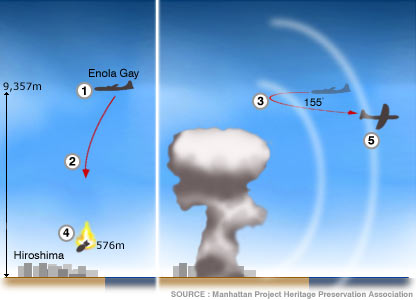The last member of Enola Gay, the B-29 that dropped the first atom bomb's crew has died.

Van Kirk (3rd from the left); the last surviving member of Enola Gay's crew has died
The last surviving member of the US crew that dropped an atomic bomb on Hiroshima, hastening the end of World War II and moving the world into the atomic age, has died. (Associated press)
Theodore "Dutch" Van Kirk died on Monday (local time) of natural causes at the retirement home where he lived in Georgia, his son Tom Van Kirk said. He was 93.
Van Kirk flew nearly 60 bombing missions, but it was a single mission in the Pacific that secured him a place in history. He was 24 years old when he served as navigator on the Enola Gay, the B-29 Superfortress that dropped the first atomic bomb deployed in wartime over the Japanese city of Hiroshima on August 6, 1945.
He was teamed with pilot Paul Tibbets and bombardier Tom Ferebee for Special Mission No. 13.
Signed Enola Gay postcard Tibbet (L) and Van Kirk (R)
The mission went perfectly, Van Kirk told The Associated Press in a 2005 interview. He guided the bomber through the night sky, just 15 seconds behind schedule, he said. As the 4080-kilogram bomb nicknamed "Little Boy" fell toward the sleeping city, he and his crewmates hoped to escape with their lives.
They didn't know whether the bomb would actually work and, if it did, whether its shockwaves would rip their plane to shreds. They counted - one thousand one, one thousand two - reaching the 43 seconds they'd been told it would take for detonation and heard nothing.

"I think everybody in the plane concluded it was a dud. It seemed a lot longer than 43 seconds," Van Kirk recalled.
Then came a bright flash. Then a shockwave. Then another shockwave.
The blast and its aftereffects killed 140,000 in Hiroshima.
Three days after Hiroshima, a second atomic bomb was dropped on Nagasaki. The blast and its aftermath claimed 80,000 lives. Six days after the Nagasaki bombing, Japan surrendered.

Whether the United States should have used the atomic bomb has been debated ever since. Van Kirk told the AP he thought it was necessary because it shortened the war and eliminated the need for an Allied land invasion that could have cost more lives on both sides.
"I honestly believe the use of the atomic bomb saved lives in the long run. There were a lot of lives saved. Most of the lives saved were Japanese," Van Kirk said.
But it also made him wary of war.
"The whole World War II experience shows that wars don't settle anything. And atomic weapons don't settle anything," he said. "I personally think there shouldn't be any atomic bombs in the world - I'd like to see them all abolished. "But if anyone has one," he added, "I want to have one more than my enemy."
Van Kirk stayed on with the military for a year after the war ended. Then he went to school, earned degrees in chemical engineering and signed on with DuPont, where he stayed until he retired in 1985.
Like many World War II veterans, Van Kirk didn't talk much about his service until much later in his life when he spoke to school groups, his son said.

"Dutch" Van Kirk
"I didn't even find out that he was on that mission until I was 10 years old and read some old news clippings in my grandmother's attic," Tom van Kirk told the AP in a phone interview Tuesday.
"I know he was recognised as a war hero, but we just knew him as a great father," Tom van Kirk said.

Signed photograph of Enola Gay (11 signatures) also the only known photo with "Boxcar" the plane that dropped the Nagasaki bomb, in the background.

Paul Tibbets
After the war, the Enola Gay returned to the United States, where it was operated from Roswell Army Air Field, New Mexico. It was flown to Kwajalein for the Operation Crossroads nuclear tests in the Pacific, but was not chosen to make the test drop at Bikini Atoll. Later that year it was transferred to the Smithsonian Institution, and spent many years parked at air bases exposed to the weather and souvenir hunters, before being disassembled and transported to the Smithsonian's storage facility at Suitland, Maryland, in 1961.
In the 1980s, veterans groups began agitating for the Smithsonian to put the aircraft on display. The cockpit and nose section of the aircraft were exhibited at the National Air and Space Museum (NASM), below, in downtown Washington, D.C., for the bombing's 50th anniversary in 1995, amid a storm of controversy. Since 2003, the entire restored B-29 has been on display at NASM's Steven F. Udvar-Hazy Center.

No comments:
Post a Comment